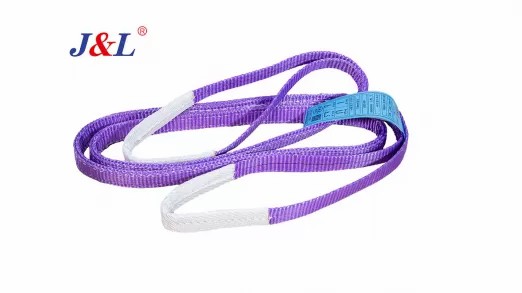Release time: Dec. 10, 2024
When it comes to lifting and rigging operations, safety is non-negotiable. For any lifting sling manufacturer, such as Juli Sling, ensuring the highest safety standards is a priority. A key factor in achieving this is understanding and adhering to the Working Load Limit (WLL), a critical parameter that determines the safe operating capacity of lifting equipment.

The Working Load Limit (WLL) is the maximum load that a lifting device, such as a sling, hook, or rope, can safely support under normal operating conditions. It is calculated based on the Minimum Breaking Strength (MBS) of the material, divided by a safety factor. The safety factor accounts for potential wear and tear, unexpected stress, and variations in the material's performance during use.
Historically, the term Safe Working Load (SWL) or Normal Working Load (NWL) was used to describe this limit. However, SWL has become an outdated term due to its ambiguity. The industry now uses WLL, a more precise designation that clearly outlines the safety parameters of lifting devices.
1.Safety: The primary purpose of WLL is to ensure that the sling does not exceed the maximum load it can safely support. Overloading a sling can cause it to break or fail, leading to accidents, equipment damage, or even injuries.
2.Prevents Equipment Failure: By adhering to the WLL, the longevity and integrity of the lifting sling are maintained. Operating within the WLL reduces wear and tear, preventing premature failure.
3.Compliance with Regulations: Many industries have strict safety regulations and standards that require operators to use lifting equipment within its specified WLL. Not following these standards can result in legal consequences and jeopardize the safety of workers.
4.Optimal Performance: Staying within the WLL ensures that the lifting sling performs as intended, providing efficient and safe lifting without the risk of overloading or damaging the equipment.
Polyester Slings, Nylon Slings, and Industrial Slings are essential lifting devices used in various industries, with Working Load Limits (WLL) typically ranging from 1 ton to 24 tons depending on the material, design, and application. Polyester slings are favored for their flexibility, abrasion resistance, and suitability for lifting heavy loads without stretching, with a WLL that generally ranges between 1T and 12T.
Nylon slings, known for their high strength and durability, often have a WLL from 1T to 24T, making them ideal for more demanding lifting tasks. Industrial slings, which can include combinations of materials like wire ropes or chain slings, also fall within this WLL range, providing reliable performance in heavy-duty lifting environments. It's crucial to select the right sling based on the specific WLL and the load requirements to ensure safe and efficient operations.
Our webbing slings and round slings are our top-selling products, offering excellent strength, versatility, and safety in lifting operations. The Working Load Limit (WLL) of webbing slings ranges from 1 ton to 24 tons, making them ideal for a wide range of applications, from light to heavy-duty lifting tasks. These slings are made from high-quality polyester, offering outstanding resistance to abrasion, UV damage, and chemicals, while maintaining flexibility and ease of use.
On the other hand, our round slings have a WLL ranging from 1 ton to 10 tons, known for their superior strength and stretchability. Made from polyester or nylon, round slings are designed to handle dynamic loads and provide a strong, reliable solution for lifting irregular or heavy loads. Both products are engineered for maximum durability and are widely trusted in industries such as construction, manufacturing, and logistics.
Both webbing slings and round slings are engineered for maximum durability and are widely trusted in industries such as construction, manufacturing, and logistics. These products are designed to withstand challenging lifting conditions and provide a safe, reliable solution for all types of lifting tasks.
Weakest Component Testing takes into account that forces can vary significantly depending on speed and direction changes. In the event of an accident, different parts of the net and straps will experience varying forces at any given moment. In this method, the Working Load Limit (WLL) is calculated by dividing the straight-pull tensile strength of the net’s weakest critical component by a safety factor of 3. This approach is designed to provide a maximum WLL for the worst-case scenario, which often results in a lower WLL value.
Total Assembly Testing assumes that all forces are distributed equally across all straps, ignoring potential changes in speed and direction. It is carried out using a basket method, where weight is gradually added to the net until it fails. The WLL is determined by dividing the maximum failure weight by a safety factor, which typically ranges from 1.5 to 3. The lower the safety factor, the larger the resulting WLL. This method gives a theoretical maximum WLL based on controlled conditions, which often leads to a larger, more impressive number.
Aggregate Working Load Limit refers to the total weight of cargo that can be safely secured on a truck bed, based on a given WLL. This is typically calculated as twice the WLL of the direct restraint used. While this method may seem confusing, it is a standard convention used in the cargo securement industry.
Juli Sling is a globally recognized lifting sling manufacturer specializing in the production of high-quality lifting devices, including wire rope slings, round slings, and custom solutions. With decades of experience and a commitment to safety, Juli Sling provides durable and reliable products for industries worldwide.